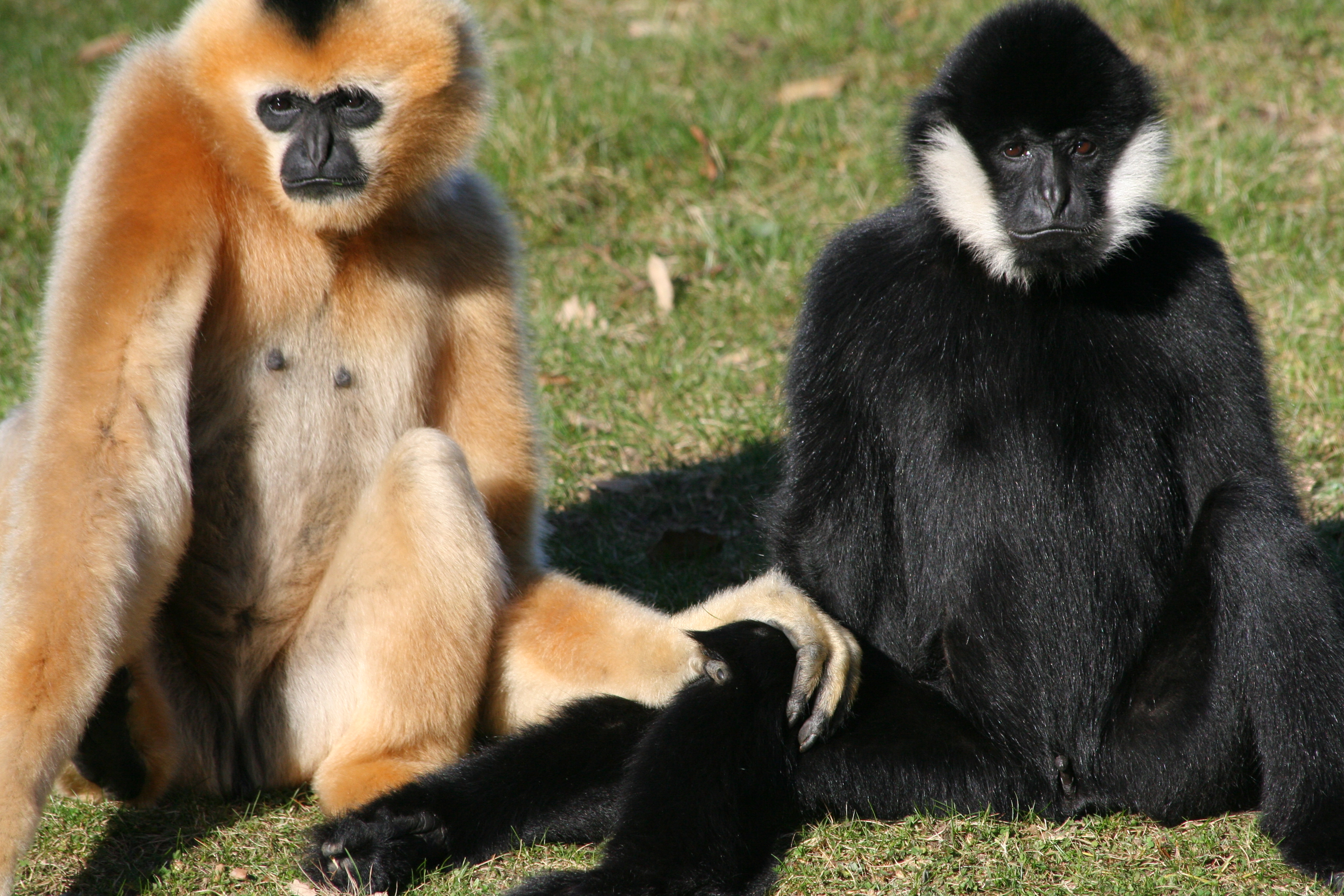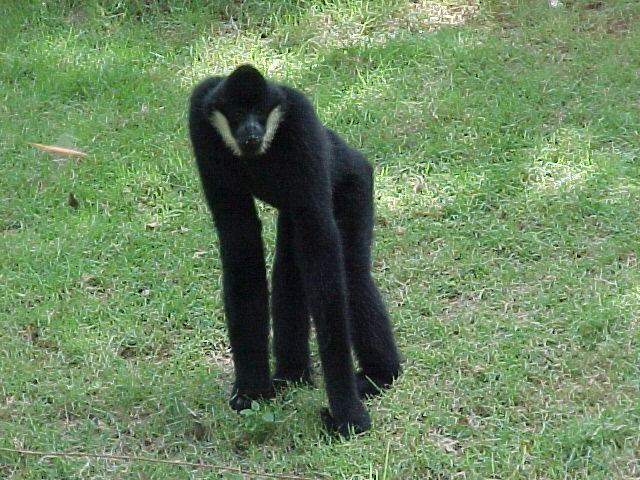|
Nomascus
''Nomascus'' is the second-most speciose genus of the gibbon family, Hylobatidae. Originally, this genus was a subgenus of ''Hylobates'', with all individuals considered to be one species, ''H. concolor''. Species within ''Nomascus'' are characterized by 52 chromosomes. Some species are all-black, some are a lighter beige or peach hue, with a distinct black tuft of crown fur, while others have notable, light-colored cheek “patches”. ''Nomascus'' is endemic from southern China (Yunnan) to southern Vietnam, and can also be found on Hainan. Every species within this genus are either endangered or critically endangered; the Eastern black crested gibbon (''Nomascus nasutus'') has been deemed "the most-critically endangered ape species in the world". Extant species Classification * Family Hylobatidae: gibbons ** Genus '' Hylobates'' ** Genus '' Hoolock'' ** Genus '' Symphalangus'' ** Genus ''Nomascus'' *** Black crested gibbon The black crested gibbon (''Noma ... [...More Info...] [...Related Items...] OR: [Wikipedia] [Google] [Baidu] |
Northern White-cheeked Gibbon
The northern white-cheeked gibbon (''Nomascus leucogenys'') is a Critically Endangered species of gibbon native to South East Asia. It is closely related to the southern white-cheeked gibbon (''Nomascus siki''), with which it was previously considered conspecific. The females of the two species are virtually indistinguishable in appearance. The genome of ''N. leucogenys'' was sequenced and published in 2011. Description Northern white-cheeked gibbons are sexually dimorphic, with males and females having different colourations and the former also being slightly larger. Males have black hair over their entire bodies, except for distinct white patches on their cheeks, as well as a prominent tuft of hair on the crown of head, and a gular sac. Females are reddish-tan in colour, lack a cranial tuft, and have a crest of black or dark brown fur running from the crown to the nape of the neck. They are reported to have an average weight of , although this is based on only a small num ... [...More Info...] [...Related Items...] OR: [Wikipedia] [Google] [Baidu] |
Nomascus Concolor
The black crested gibbon (''Nomascus concolor'') is a Critically Endangered species of gibbon found in China, Laos, and northern Vietnam, with four subspecies. Taxonomy The taxonomy of the species is confused. Previously grouped in the genus ''Hylobates'', currently four subspecies are recognized. *Central Yunnan black crested gibbon (''Nomascus concolor jingdongensis''), Yunnan province, China * West Yunnan black crested gibbon (''N. c. furvogaster''), Yunnan province, China * Laotian black crested gibbon (''N. c. lu''), Laos * Tonkin black crested gibbon (''N. c. concolor''), northern Vietnam, Yunnan province, China. Description The length from the head to the end of body is and it weighs from . The species exhibits sexual dichromatism, the male is completely black, while the female is a golden or buff colour with variable black patches, including a black streak on the head. Behavior Gibbons are forest dwellers and are well known for their habit of swinging between ... [...More Info...] [...Related Items...] OR: [Wikipedia] [Google] [Baidu] |
Black Crested Gibbon
The black crested gibbon (''Nomascus concolor'') is a Critically Endangered species of gibbon found in China, Laos, and northern Vietnam, with four subspecies. Taxonomy The taxonomy of the species is confused. Previously grouped in the genus '' Hylobates'', currently four subspecies are recognized. * Central Yunnan black crested gibbon (''Nomascus concolor jingdongensis''), Yunnan province, China * West Yunnan black crested gibbon (''N. c. furvogaster''), Yunnan province, China * Laotian black crested gibbon (''N. c. lu''), Laos * Tonkin black crested gibbon (''N. c. concolor''), northern Vietnam, Yunnan province, China. Description The length from the head to the end of body is and it weighs from . The species exhibits sexual dichromatism, the male is completely black, while the female is a golden or buff colour with variable black patches, including a black streak on the head. Behavior Gibbons are forest dwellers and are well known for their habit of swinging be ... [...More Info...] [...Related Items...] OR: [Wikipedia] [Google] [Baidu] |
Hainan Black Crested Gibbon
The Hainan black-crested gibbon (''Nomascus hainanus''), also called the Hainan gibbon, is a Critically Endangered species of gibbon found only on Hainan Island, in the South China Sea. It was formerly considered a subspecies of the eastern black crested gibbon (''N. nasutus'') from Hòa Bình and Cao Bằng provinces of Vietnam and Jingxi County in Guangxi Zhuang Autonomous Region, China. Molecular data, together with morphology and call differences, suggest it is a separate species. Its habitat consists of broad-leaved forests and semi-deciduous monsoon forests. It feeds on ripe, sugar-rich fruit, such as figs and, at times, leaves, and insects. Current status Hainan black-crested gibbons are under grave threat of extinction. They are currently identified as critically endangered on the International Union for Conservation of Nature’s Red List. Historically, they were widespread in China: Government records dating back to the 17th century state that their range used t ... [...More Info...] [...Related Items...] OR: [Wikipedia] [Google] [Baidu] |
Nomascus Hainanus
The Hainan black-crested gibbon (''Nomascus hainanus''), also called the Hainan gibbon, is a Critically Endangered species of gibbon found only on Hainan Island, in the South China Sea. It was formerly considered a subspecies of the eastern black crested gibbon (''N. nasutus'') from Hòa Bình and Cao Bằng provinces of Vietnam and Jingxi County in Guangxi Zhuang Autonomous Region, China. Molecular data, together with morphology and call differences, suggest it is a separate species. Its habitat consists of broad-leaved forests and semi-deciduous monsoon forests. It feeds on ripe, sugar-rich fruit, such as figs and, at times, leaves, and insects. Current status Hainan black-crested gibbons are under grave threat of extinction. They are currently identified as critically endangered on the International Union for Conservation of Nature’s Red List. Historically, they were widespread in China: Government records dating back to the 17th century state that their range used to c ... [...More Info...] [...Related Items...] OR: [Wikipedia] [Google] [Baidu] |
Tonkin Black Crested Gibbon
The Tonkin black crested gibbon (''Nomascus concolor concolor'') is a critically endangered subspecies of the black crested gibbon found in Yunnan and Vietnam. Distribution Geographic range The Tonkin black crested gibbon is found occurs in central and southwestern Yunnan (China) and in northern Vietnam, precisely in Lao Cai, Yen Bai, Son La and Lai Châu provinces.Geissmann, T., Dang, N.X., Lormée, N. and Momberg, F. 2000. Vietnam primate conservation status review 2000 - Part 1: Gibbons. Fauna and Flora International, Indochina Programme, Hanoi. 130 pp. Habitat The Tonkin black-crested gibbon lives in forests at altitudes of between . Behavior Social structure The Tonkin black-crested gibbon lives in groups. Feeding The Tonkin black-crested gibbon feeds mainly on leaves, fruits, figs and flowers. Conservation Status As of November 2015, the Tonkin black crested gibbon is critically endangered. Threats The Tonkin black-crested gibbon is threatened by ... [...More Info...] [...Related Items...] OR: [Wikipedia] [Google] [Baidu] |
Gibbon
Gibbons () are apes in the family Hylobatidae (). The family historically contained one genus, but now is split into four extant genera and 20 species. Gibbons live in subtropical and tropical forests from eastern Bangladesh and Northeast India to Southeast Asia and Indonesia (including the islands of Sumatra, Borneo and Java). Also called the lesser apes, gibbons differ from the great apes ( chimpanzees, gorillas, orangutans and humans) in being smaller, exhibiting low sexual dimorphism, and not making nests. Like all of the apes, gibbons are tailless. Unlike most of the great apes, gibbons frequently form long-term pair bonds. Their primary mode of locomotion, brachiation, involves swinging from branch to branch for distances up to , at speeds as fast as . They can also make leaps up to , and walk bipedally with their arms raised for balance. They are the fastest of all tree-dwelling, nonflying mammals. Depending on the species and sex, gibbons' fur coloration varies from ... [...More Info...] [...Related Items...] OR: [Wikipedia] [Google] [Baidu] |
Hylobatidae
Gibbons () are apes in the Family (biology), family Hylobatidae (). The family historically contained one genus, but now is split into four extant genera and 20 species. Gibbons live in subtropical and tropical forests from eastern Bangladesh and Northeast India to Mainland Southeast Asia, Southeast Asia and Indonesia (including the islands of Sumatra, Borneo and Java (island), Java). Also called the lesser apes, gibbons differ from the great apes (pan (genus), chimpanzees, gorillas, orangutans and humans) in being smaller, exhibiting low sexual dimorphism, and not making nests. Like all of the apes, gibbons are tailless. Unlike most of the great apes, gibbons frequently form long-term pair bonds. Their primary mode of locomotion, brachiation, involves swinging from branch to branch for distances up to , at speeds as fast as . They can also make leaps up to , and walk bipedally with their arms raised for balance. They are the fastest of all tree-dwelling, nonflying mammals. Depe ... [...More Info...] [...Related Items...] OR: [Wikipedia] [Google] [Baidu] |
Southern White-cheeked Gibbon
The southern white-cheeked gibbon (''Nomascus siki'') is a species of gibbon native to Vietnam and Laos. It is closely related to the northern white-cheeked gibbon (''Nomascus leucogenys'') and the yellow-cheeked gibbon (''Nomascus gabriellae''); it has previously been identified as a subspecies of each of these. Description and habitat Members of the species are not a uniform colour; unweaned juveniles are a light brown, turning to black after weaning. Adult males remain black, but adult females are brown. The name of the species is taken from the male's facial markings, a large patch of white fur around the edge of the mouth - this distinguishes it from a male of ''N. leucogenys'', which has the white in a streak along the cheeks. Females have a thin edging of white around the face.Groves, Colin. ''Speciation and biogeography of Vietnam’s primates''. Vietnamese Journal of Primatology (2007) 1, 27-40Digital copy The species lives in lowland broadleaf forest, with some popu ... [...More Info...] [...Related Items...] OR: [Wikipedia] [Google] [Baidu] |
Nomascus Siki
The southern white-cheeked gibbon (''Nomascus siki'') is a species of gibbon native to Vietnam and Laos. It is closely related to the northern white-cheeked gibbon (''Nomascus leucogenys'') and the yellow-cheeked gibbon (''Nomascus gabriellae''); it has previously been identified as a subspecies of each of these. Description and habitat Members of the species are not a uniform colour; unweaned juveniles are a light brown, turning to black after weaning. Adult males remain black, but adult females are brown. The name of the species is taken from the male's facial markings, a large patch of white fur around the edge of the mouth - this distinguishes it from a male of ''N. leucogenys'', which has the white in a streak along the cheeks. Females have a thin edging of white around the face.Groves, Colin. ''Speciation and biogeography of Vietnam’s primates''. Vietnamese Journal of Primatology (2007) 1, 27-40Digital copy The species lives in lowland broadleaf forest, with some popul ... [...More Info...] [...Related Items...] OR: [Wikipedia] [Google] [Baidu] |

